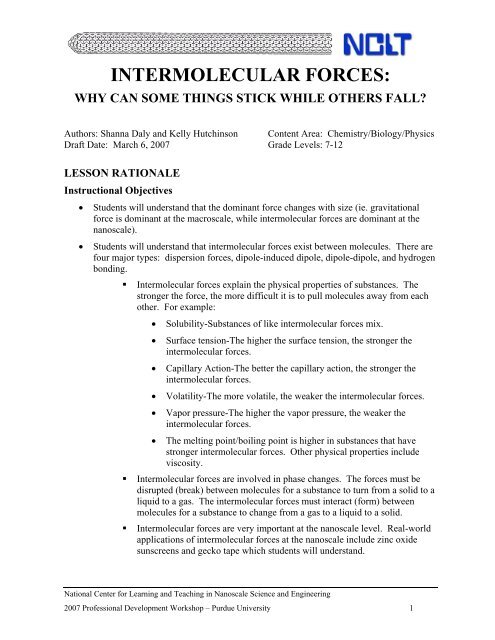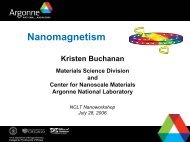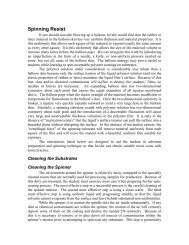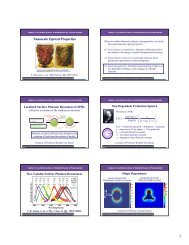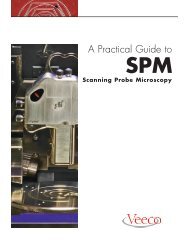Lesson - Intermolecular Forces - NCLT
Lesson - Intermolecular Forces - NCLT
Lesson - Intermolecular Forces - NCLT
You also want an ePaper? Increase the reach of your titles
YUMPU automatically turns print PDFs into web optimized ePapers that Google loves.
INTERMOLECULAR FORCES:<br />
WHY CAN SOME THINGS STICK WHILE OTHERS FALL?<br />
Authors: Shanna Daly and Kelly Hutchinson Content Area: Chemistry/Biology/Physics<br />
Draft Date: March 6, 2007 Grade Levels: 7-12<br />
LESSON RATIONALE<br />
Instructional Objectives<br />
• Students will understand that the dominant force changes with size (ie. gravitational<br />
force is dominant at the macroscale, while intermolecular forces are dominant at the<br />
nanoscale).<br />
• Students will understand that intermolecular forces exist between molecules. There are<br />
four major types: dispersion forces, dipole-induced dipole, dipole-dipole, and hydrogen<br />
bonding.<br />
• <strong>Intermolecular</strong> forces explain the physical properties of substances. The<br />
stronger the force, the more difficult it is to pull molecules away from each<br />
other. For example:<br />
• Solubility-Substances of like intermolecular forces mix.<br />
• Surface tension-The higher the surface tension, the stronger the<br />
intermolecular forces.<br />
• Capillary Action-The better the capillary action, the stronger the<br />
intermolecular forces.<br />
• Volatility-The more volatile, the weaker the intermolecular forces.<br />
• Vapor pressure-The higher the vapor pressure, the weaker the<br />
intermolecular forces.<br />
• The melting point/boiling point is higher in substances that have<br />
stronger intermolecular forces. Other physical properties include<br />
viscosity.<br />
• <strong>Intermolecular</strong> forces are involved in phase changes. The forces must be<br />
disrupted (break) between molecules for a substance to turn from a solid to a<br />
liquid to a gas. The intermolecular forces must interact (form) between<br />
molecules for a substance to change from a gas to a liquid to a solid.<br />
• <strong>Intermolecular</strong> forces are very important at the nanoscale level. Real-world<br />
applications of intermolecular forces at the nanoscale include zinc oxide<br />
sunscreens and gecko tape which students will understand.<br />
National Center for Learning and Teaching in Nanoscale Science and Engineering<br />
2007 Professional Development Workshop – Purdue University 1
Big Idea<br />
• <strong>Forces</strong>: All interactions can be described by multiple types of forces, but the relative<br />
impact of these forces change with scale. On the nanoscale, a range of electrical forces<br />
with varying strengths tend to dominate the interactions between objects.<br />
Standards<br />
• Indiana Learning Standards:<br />
7 th Grade<br />
7.1.7 – Explain how engineers, architects, and others who engage in design and technology use<br />
scientific knowledge to solve practical problems.<br />
8 th Grade<br />
Chemistry 1<br />
7.1.9 – Explain how societies influence what types of technology are developed and used in<br />
fields such as agriculture, manufacturing, sanitation, medicine, warfare, transportation,<br />
information processing, and communication.<br />
7.7.3 – Describe how physical and biological systems tend to change until they reach<br />
equilibrium and remain that way unless their surroundings change.<br />
8.1.6 – Identify the constraints that must be taken into account as a new designing is<br />
developed, such as gravity and the properties of the materials to be used.<br />
8.1.8 – Explain that humans help shape the future by generating knowledge, developing new<br />
technologies, and communicating ideas to others.<br />
8.2.7 – Participate in group discussions on scientific topics by restating or summarizing<br />
accurately what others have said, asking for clarification or elaboration, and expressing<br />
alternative positions.<br />
8.3.8 – Explain that all matter is made up of atoms which are far too small to see directly<br />
though an optical microscope. Understand that the atoms of any element are similar but are<br />
different from atoms of other elements. Further understand that atoms may stick together in<br />
well-defined molecules or may be packed together in large arrays. Also understand that<br />
different arrangements of atoms into groups comprise all substances.<br />
8.3.10 – Explain that increased temperature means that atoms have a greater average kinetic<br />
energy of motion and that most gases expand when heated.<br />
8.3.16 – Explain that every object exerts gravitational fore on every other object and that the<br />
force depends on how much mass the objects have and how far apart they are.<br />
8.3.18 – Investigate and explain that electric currents and magnets can exert force on each<br />
other.<br />
8.7.1 – Explain that a system usually has some properties that are different from those of its<br />
parts but appear because of the interaction of those parts.<br />
8.7.3 – Use technology to assist in graphing and with simulations that compute and display<br />
results of changing factors in models.<br />
C.1.26 – Describe physical changes and properties of matter through sketches and descriptions<br />
of the involved materials.<br />
National Center for Learning and Teaching in Nanoscale Science and Engineering<br />
2007 Professional Development Workshop – Purdue University 2
Physics 1<br />
C.1.28 – Explain that chemical bonds between atoms in molecules, such as H 2 , CH 4 , NH 3 ,<br />
C 2 H4, N 2 , Cl 2 , and many large biological molecules are covalent.<br />
C.1.35 – Infer and explain physical properties of substances, such as melting points, boiling<br />
points, and solubility, based on the strength of molecular attractions.<br />
C.1.36 – Describe the nature of ionic, covalent, and hydrogen bonds and give examples of how<br />
they contribute to the formation of various types of compounds.<br />
P.1.10 – Demonstrate an understanding of the inverse square nature of gravitational and<br />
electrostatic forces.<br />
Integrated Chemistry – Physics<br />
CP.1.1 – Understand and explain that atoms have a positive nucleus (consisting of relatively<br />
massive positive protons and neutral neutrons) surrounded by negative electrons of much<br />
smaller mass, some of which may be lost, gained, or shared when interacting with other atoms.<br />
CP.1.11 – Understand and give examples to show that an enormous variety of biological,<br />
chemical, and physical phenomena can be explained by changes in the arrangement and motion<br />
of atoms and molecules.<br />
CP.1.27 – Recognize and describe that gravitational force is an attraction between masses<br />
and that the strength of the force is proportional to the masses and decreases rapidly as the<br />
square of the distance between the masses increases.<br />
CP.1.28 – Realize and explain that electromagnetic forces acting within and between atoms<br />
are vastly stronger than the gravitational forces acting between atoms.<br />
CP.1.29 – Understand and explain that at the atomic level, electric forces between oppositely<br />
charged electrons and protons hold atoms and molecules together and thus, are involved in all<br />
chemical reactions.<br />
CP.1.30 – Understand and explain that in materials, there are usually equal proportions of<br />
positive and negative charges, making the materials as a whole electrically neutral. However,<br />
also know that a very small excess or deficit of negative charges will produce noticeable<br />
electric forces.<br />
• National Science Education Standards<br />
Content Standards 5-8<br />
Content Standard A: Science as Inquiry<br />
o<br />
o<br />
Abilities necessary to do scientific inquiry<br />
Understandings about scientific inquiry<br />
Content Standards 9-12<br />
Content Standard A: Science as Inquiry<br />
o Abilities necessary to do scientific inquiry<br />
o Understandings about scientific inquiry<br />
National Center for Learning and Teaching in Nanoscale Science and Engineering<br />
2007 Professional Development Workshop – Purdue University 3
Content Standard B: Physical Science<br />
o<br />
o<br />
o<br />
o<br />
Matter is made of minute particles called atoms, and atoms are composed of even smaller<br />
components. These components have measurable properties, such as mass and electrical<br />
charge. Each atom has a positively charged nucleus surrounded by negatively charged<br />
electrons. The electric force between the nucleus and electrons holds the atom together.<br />
Gravitation is a universal force that each mass exerts on any other mass. The strength of the<br />
gravitational force between two masses is proportional to the masses and inversely<br />
proportional to the square of the distance between them.<br />
The electric force is a universal force that exits between any two charges objects. Opposite<br />
charges attract while like charges repel. The strength of the force is proportional to the<br />
charges, and, as well gravitation, inversely proportional to the square of the distance<br />
between them.<br />
Between any two charged particles, electric force is vastly greater then the gravitational<br />
force. Most observable forces such as those exerted by a coiled spring or friction may be<br />
traced to electric forces acting between atoms and molecules.<br />
Content Standard E: Science and Technology<br />
o<br />
Science often advances with the introduction of new technologies. Solving technological<br />
problems often results in new scientific knowledge. New technologies often extend the<br />
current levels of scientific understanding and introduce new areas of research.<br />
• Benchmarks for Science Literacy-Project 2061<br />
Grades 6-8<br />
3C: The Nature of Technology – Issues in Technology<br />
o Societies influence what aspects of technology are developed and how these are used.<br />
People control technology (as well as science) and are responsible for its effects.<br />
4D: The Physical Setting – Structure of Matter<br />
o<br />
o<br />
All matter is made up of atoms, which are far too small to see directly through a<br />
microscope. The atoms of any element are alike but are different from atoms of other<br />
elements. Atoms may stick together in well-defined molecules or may be packed together<br />
in large arrays. Different arrangements of atoms into groups compose all substances.<br />
Atoms and molecules are perpetually in motion. Increased temperature mans greater<br />
average energy of motion, so most substances expand when heated. In solids, the atoms are<br />
closely locked in position and can only vibrate. In liquids, the atoms or molecules have<br />
higher energy, are more loosely connected, and can slide past one another; some molecules<br />
may get enough energy to escape into a gas. In gases, the atoms or molecules have still<br />
more energy and are free of one another except during occasional collisions.<br />
4G: The Physical Setting – <strong>Forces</strong> of Nature<br />
o<br />
Every object exerts gravitational force on every other object. The force depends on how<br />
much mass the objects have and on how far apart they are. The force is hard to detect<br />
unless at least one of the objects has a lot of mass.<br />
12D: Habits of Mind – Communication Skills<br />
o<br />
Locate information in reference books, back issues of newspapers and magazines, compact<br />
discs, and computer databases.<br />
National Center for Learning and Teaching in Nanoscale Science and Engineering<br />
2007 Professional Development Workshop – Purdue University 4
Grades 9-12<br />
1C: The Nature of Science – The Scientific Enterprise<br />
o Progress in science and invention depends heavily on what else is happening in society, and<br />
history often depends on scientific and technological developments.<br />
4D: The Physical Setting – Structure of Matter<br />
o<br />
The rate of reactions among atoms and molecules depends on how often they encounter one<br />
another, which is affected by the concentration, pressure, and temperature of the reacting<br />
materials. Some atoms and molecules are highly effective in encouraging the interaction of<br />
others.<br />
4G: The Physical Setting – <strong>Forces</strong> of Nature<br />
o<br />
o<br />
Gravitational force is an attraction between masses. The strength of the fore is proportional<br />
to the masses and weakens rapidly with increasing distance between them.<br />
Electromagnetic forces acting within and between atoms are vastly stronger than the<br />
gravitational forces acting between the atoms. At the atomic level, electric forces between<br />
oppositely charged electrons and protons hold atoms and molecules together and thus are<br />
involved in chemical reactions. On a larger scale, these forces hold solid and liquid<br />
materials together and act between objects when they are in contact – as in sticking or<br />
sliding friction.<br />
8B: The Designed World – Materials and Manufacturing<br />
o<br />
Increased knowledge of the molecular structure of materials helps in the design and<br />
synthesis of new materials for special purposes.<br />
11D: Common Themes – Scale<br />
o<br />
Because different properties are not affected to the same degree by changes in scale, large<br />
changes in scale typically change the way that things work in physical, biological, or social<br />
systems.<br />
12D: Habits of Mind – Communication Skills<br />
o<br />
Participate in group discussions on scientific topics by restating or summarizing accurately<br />
what others have said, asking for clarification or elaboration, and expressing alternative<br />
positions.<br />
LESSON PREPARATION<br />
***Students should work in groups of 2-3***<br />
Materials for Discovery should be put as stations around the room. You will only need to<br />
have a limited number of supplies at each location. Volumes at each station are<br />
estimated. The liquids should be kept in containers/ jars with lids.<br />
Materials<br />
Discovery: Part A<br />
Item<br />
Textbooks<br />
Computers w/Internet access<br />
National Center for Learning and Teaching in Nanoscale Science and Engineering<br />
Number/Amount<br />
2-3/ station<br />
1/ station<br />
2007 Professional Development Workshop – Purdue University 5
Discovery: Part B-1<br />
Item<br />
Water in small sealed container (50 mL)<br />
Ethanol in small sealed container (50 mL)<br />
Cyclohexane in small sealed container (50 mL)<br />
Disposable pipet (one per chemical)<br />
Small test tubes<br />
Number/Amount<br />
1/ station<br />
1/ station<br />
1/ station<br />
3/ station<br />
3/ group<br />
Discovery: Part B-2<br />
Item<br />
Water in small sealed container (30 mL)<br />
Ethanol in small sealed container (30 mL)<br />
Cyclohexane in small sealed container (30 mL)<br />
Disposable pipet (one per chemical)<br />
Wax paper (small square piece)<br />
Pennies<br />
Metric ruler<br />
Number/Amount<br />
1/ station<br />
1/ station<br />
1/ station<br />
3/ station<br />
1/ group<br />
3/ station<br />
1/ station<br />
Discovery: Part B-3<br />
Item<br />
Water in small sealed container (10 mL)<br />
Ethanol in small sealed container (10 mL)<br />
Cyclohexane in small sealed container (10 mL)<br />
Capillary tubes (1.5-1.8 x 100 mm); (label for each chemical)<br />
Metric ruler<br />
Number/Amount<br />
1/ station<br />
1/ station<br />
1/ station<br />
3/ station<br />
1/ station<br />
Discovery: Part B-4<br />
Item<br />
Water in small sealed container (15 mL)<br />
Ethanol in small sealed container (15 mL)<br />
Cyclohexane in small sealed container (15 mL)<br />
Disposable pipet (one per chemical)<br />
Number/Amount<br />
1/ station<br />
1/ station<br />
1/ station<br />
3/ station<br />
National Center for Learning and Teaching in Nanoscale Science and Engineering<br />
2007 Professional Development Workshop – Purdue University 6
Glass plate (microscope slide)<br />
Stopwatch<br />
1/ group<br />
1/ station<br />
Discovery: Part C<br />
Item<br />
Computers w/Internet access<br />
Number/Amount<br />
1/ station<br />
Discovery: Part D<br />
Dixie cups, 3 oz.<br />
Zinc oxide powder (Flinn Z0013: 500 grams for $12.60)<br />
Darvan C-N free sample at:<br />
http://www.rtvanderbilt.com/wwwprd/ceramics_4.htm<br />
Popsicle sticks or coffee stirrers<br />
Disposable pipets (1 for water, 1 for Darvan C-N)<br />
Distilled water<br />
1/ group<br />
~10 g/ group<br />
2 mL/ group<br />
1/ group<br />
2/ station<br />
6 mL/ group<br />
Discovery: Part E<br />
Granulated sugar<br />
Powdered sugar<br />
Container to catch sugars<br />
Black contact paper on cardboard (1 for each sugar)<br />
Plastic spoons (1 for each sugar)<br />
5 tsp/ station<br />
5 tsp/ station<br />
2/ station<br />
2 pieces/ station<br />
2/ station<br />
National Center for Learning and Teaching in Nanoscale Science and Engineering<br />
2007 Professional Development Workshop – Purdue University 7
Discussion<br />
Item<br />
Number/Amount<br />
250-mL Erlenmeyer flask 3<br />
2-hole rubber stopper 3<br />
Latex tubing (3-4 inches) 3<br />
Pinch clamp 3<br />
Glass tubing bent into manometer 3<br />
Food coloring/ pipet 1<br />
Water<br />
20 mL<br />
Rubbing alcohol (2-propanol)<br />
20 mL<br />
Acetone<br />
20 mL<br />
Taped “beaker” on classroom floor 1<br />
Nametags for oxygen/hydrogen atoms<br />
1/student<br />
Overhead transparencies (optional)<br />
1/group<br />
Lab<br />
Item<br />
Textbooks or Computers w/Internet access<br />
Water (unknown A)<br />
Hexane (unknown B)<br />
Acetone (unknown C)<br />
Butanol (unknown D)<br />
Gycerol (unknown E)<br />
Cyclohexane (test reagent)<br />
Ethanol (test reagent)<br />
Water (test reagent)<br />
Disposable pipet (1 per chemical)<br />
Small test tubes (in test tube rack)<br />
Glass slide or glass plate<br />
Graph paper<br />
Stopwatch<br />
Metric ruler<br />
Number/Amount<br />
1/ group<br />
25 mL/ group<br />
25 mL/ group<br />
25 mL/ group<br />
25 mL/ group<br />
25 mL/ group<br />
10 mL/ group<br />
10 mL/ group<br />
10 mL/ group<br />
8/ group<br />
6/ group<br />
1/ group<br />
1 sheet/ group<br />
1/ group<br />
1/ group<br />
National Center for Learning and Teaching in Nanoscale Science and Engineering<br />
2007 Professional Development Workshop – Purdue University 8
Capillary tubes<br />
Wax paper (small square piece)<br />
8/ group<br />
1/ group<br />
Possible Misconceptions or Student Difficulties<br />
• <strong>Intermolecular</strong> forces are actually bonds between molecules. Students especially think<br />
this with hydrogen bonds because of the name.<br />
• When water evaporates, the water molecules break apart into hydrogen and oxygen.<br />
Safety Issues<br />
• Goggles need to be worn for the Discovery (Parts B, C, & D) and the Lab.<br />
• Students should wash their hands after working with the chemicals in the discovery and<br />
lab.<br />
• Zinc oxide mixture can be disposed of in the garbage.<br />
Doing the <strong>Lesson</strong><br />
Opening: Eliciting Students’ Ideas<br />
1. Have the questions below written on the board for students to work on individually as<br />
they enter the classroom and for the first 3-5 minutes of class. Then have students get<br />
into groups (lab groups) to discuss possible answers to the questions for 5 minutes.<br />
o How can a gecko walk upside-down on a ceiling?<br />
o Why can a gecko walk upside-down on ceilings, while humans cannot?<br />
o How can you turn powdered zinc oxide into a solution that could be used in a<br />
sunscreen?<br />
2. Discovery (attached)<br />
Students work with a partner to complete a series of activities that study the concepts.<br />
They are asked to make observations, collect data, and propose explanations. By<br />
listening to the students discuss the activities in their groups, asking the students<br />
questions, and reading the students explanations, the teacher elicits the students’ ideas.<br />
National Center for Learning and Teaching in Nanoscale Science and Engineering<br />
2007 Professional Development Workshop – Purdue University 9
Investigation: Concept Development/Making Sense<br />
1. Discovery (attached)<br />
The students begin to develop the concept of intermolecular forces by creating their<br />
own models for each type of force, observing physical properties of different liquids,<br />
and observing what happens when a phase change occurs (wet-lab experiment and<br />
computer simulation). The students discuss their ideas with their lab partner and<br />
sometimes with other groups. The teacher acts as a facilitator, encouraging the students<br />
to think about their observations and provide clear explanations for their ideas.<br />
2. Large Group Discussion<br />
After the students complete the discovery, the entire class discusses their ideas of the<br />
concepts. The large group discussion focuses on three major questions that come from<br />
the discovery. The teacher helps guide the students to the scientific explanation for the<br />
phenomena they observed. The teacher provides new examples or ideas for the students<br />
to apply/test their new understandings.<br />
(1) What is chemically special about each type of intermolecular force?<br />
• Students share their understandings of each type of intermolecular force.<br />
The group discusses and critiques the different models that are presented.<br />
(Overhead transparencies could be made of the student cartoon models.)<br />
• The teacher provides examples of molecules for the students to predict<br />
the type of intermolecular force that would form between them. (Why<br />
would that type of intermolecular force form? What is the evidence?)<br />
• After classifying the examples, the students predict and discuss the<br />
relative strength of the forces between the different molecule examples.<br />
(The teacher asks the students to clarify their predictions with<br />
explanations. Then, the teacher asks how we could test their<br />
predictions—leads to the next question).<br />
(2) How do intermolecular forces relate to the physical properties of substances?<br />
• Discuss student ideas for each property examined in the discovery.<br />
Relate the explanations for their results to the concept of intermolecular<br />
forces.<br />
• Have the students predict results for similar experiments with the new<br />
molecules discussed in Question 1.<br />
• Vapor Pressure Demonstration: Manometer using water, rubbing<br />
alcohol, and acetone. Have the students make a prediction on the vapor<br />
pressure created by each liquid. (Ask them why or how they know that<br />
will happen.) Conduct the demonstration. Have the students record and<br />
explain the results.<br />
• Discuss what happened in the flasks to create the vapor pressure. This<br />
leads to the next question about phase changes.<br />
National Center for Learning and Teaching in Nanoscale Science and Engineering<br />
2007 Professional Development Workshop – Purdue University 10
(3) What happens to intermolecular forces during a phase change?<br />
• Discuss the computer simulation results. Relate them to the vapor<br />
pressure demonstration from Question 2. How does the strength of<br />
intermolecular forces impact the molecules during a phase change?<br />
• Discuss student ideas from the discovery about what happens to the<br />
molecules during a phase change (solid to liquid to gas).<br />
• Demonstration/Student Activity: Water in a Jar activity. Have the<br />
students pretend to be water molecules and go through a phase<br />
change. Then, have the students become molecules with weaker<br />
attractive forces. How does the activity change? Discuss<br />
misconceptions that arise during the activity.<br />
Follow-Up: Application of Learning<br />
1. Mystery Chemical Lab (attached)<br />
The students design their own experiment to determine the identity of five different<br />
liquids. The students can decide which properties to test, but must conduct at least three<br />
tests.<br />
2. Application Assignment (attached)<br />
The students perform the assignment that provides them an opportunity to apply their<br />
knowledge of intermolecular forces to a real-world nanoscience application. They will<br />
use data and observations collected during the discovery to assist in answering the<br />
questions.<br />
Assessment<br />
1. Discovery—Teacher asks students questions while they are completing the discovery<br />
activities. Teacher grades students’ written responses based on the completeness and<br />
thoughtfulness of their explanations.<br />
2. Large Group Discussion—Teacher asks students questions about their ideas about<br />
concepts they explored in the discovery activities.<br />
3. Mini-topic Quiz—Students are assessed on a five-question quiz related to the concepts<br />
studied in the discovery, discussion, and worksheet.<br />
4. Mystery Chemical Lab Report—Assess the students predictions and explanations (how<br />
do they know), experimental design, and conclusions (are they based on evidence? are<br />
they explained using intermolecular forces?).<br />
5. Application Assignment—How well can the students explain gecko’s feet and zinc<br />
oxide solutions using the concept of intermolecular forces? How well do the students<br />
present their findings and information to others?<br />
National Center for Learning and Teaching in Nanoscale Science and Engineering<br />
2007 Professional Development Workshop – Purdue University 11
Resources<br />
1. Phase Change Experiment Simulation<br />
http://www.chm.davidson.edu/ronutt/che115/Phase/Phase.htm<br />
2. <strong>NCLT</strong> Professional Development Workshop, Purdue University, 2006<br />
• What Attractions Exist Between Molecules? (Shanna Daly)<br />
• Using a Manometer to Measure Vapor Pressure (David Sederberg)<br />
• All About <strong>Forces</strong> (Kelly Hutchinson)<br />
• The Structure of Matter (Kelly Hutchinson)<br />
• Molecular Attractions: Why do chemicals behave the way they do (Becky<br />
Creech, <strong>Lesson</strong> plan developed during workshop from other lessons).<br />
National Center for Learning and Teaching in Nanoscale Science and Engineering<br />
2007 Professional Development Workshop – Purdue University 12
An Explanation for Teachers<br />
Sugars<br />
• The granulated sugar falls essentially grain by grain off of the black contact paper into<br />
the sugar container and all of the sugar falls off (a few grains may remain). This is due<br />
to the force of gravity on the sugar particles.<br />
• The powdered sugar falls off in one clump. There will be a trail left by the powdered<br />
sugar as well as clumps of powdered sugar remaining on the card. Even if the card is<br />
tipped upside down, these clumps will remain on the card. All of this is due to<br />
electrostatic forces, specifically Van der Waals forces, and not gravity.<br />
• The size of the object affects the dominant forces acting upon it.<br />
• IMPORTANT: The powdered sugar is not nanosized! The average particle size is 1-10<br />
μm, which is 1,000-10,000 times bigger than a nanometer.<br />
Zinc Oxide<br />
• Zinc oxide forms weakly agglomerated nanoparticles.<br />
• An aqueous dispersion of zinc oxide is very viscous due to Van der Waals interactions<br />
which in turn makes the liquid very difficult to stir.<br />
• Addition of Darvan C, a polyelectrolyte, coats each nanoparticle with negative charge.<br />
This causes the particles to repel each other significantly lowering the viscosity.<br />
• This repulsion causes the particles no longer want to stick together as much and the<br />
solution becomes easy to stir.<br />
• The behavior of the ZnO illustrates how important electrostatic forces are in<br />
determining the behavior of the ZnO solution.<br />
• The ZnO particles range from 200-800 nm which is much closer to the nanometer size<br />
range compared to the powdered sugar.<br />
Darvan-C<br />
National Center for Learning and Teaching in Nanoscale Science and Engineering<br />
2007 Professional Development Workshop – Purdue University 13


